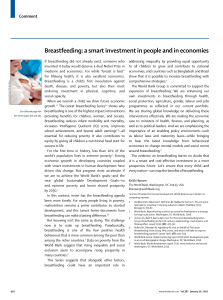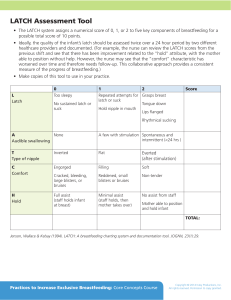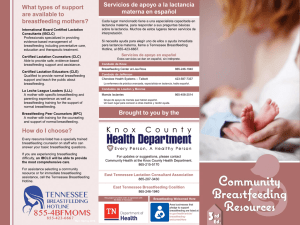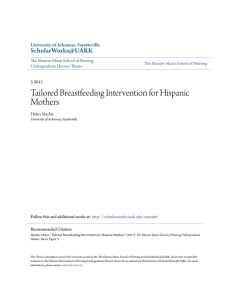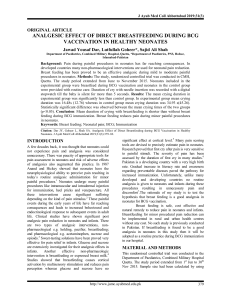July/Aug02 Streamline - Migrant Clinicians Network
Anuncio
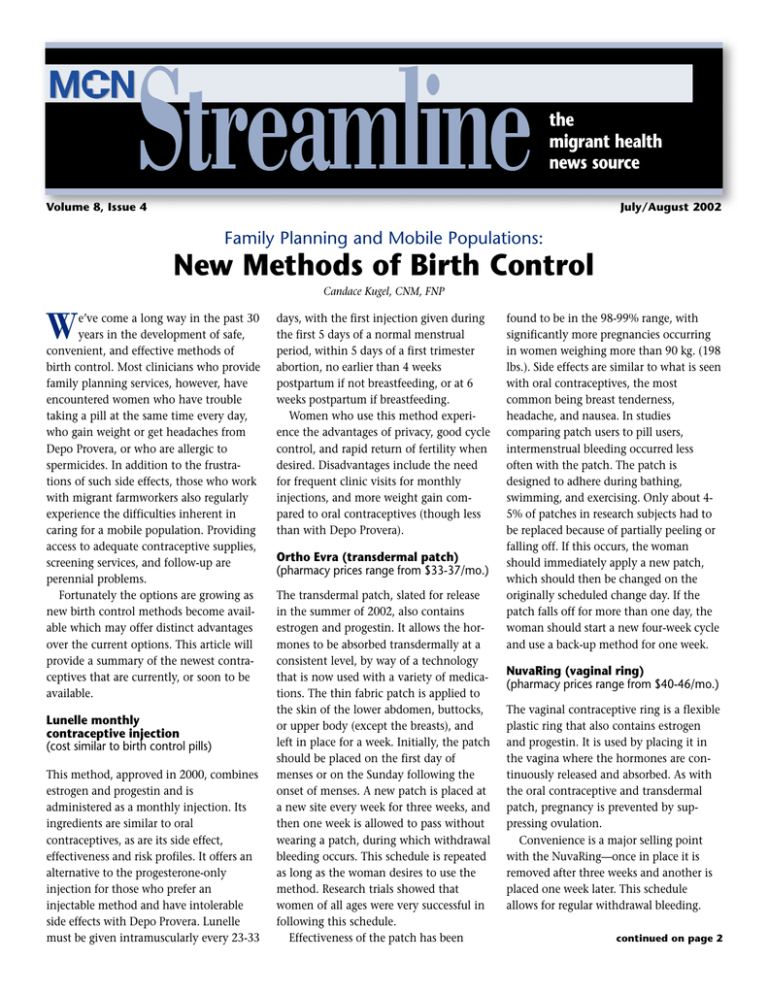
Streamline the migrant health news source Volume 8, Issue 4 July/August 2002 Family Planning and Mobile Populations: New Methods of Birth Control Candace Kugel, CNM, FNP W e’ve come a long way in the past 30 years in the development of safe, convenient, and effective methods of birth control. Most clinicians who provide family planning services, however, have encountered women who have trouble taking a pill at the same time every day, who gain weight or get headaches from Depo Provera, or who are allergic to spermicides. In addition to the frustrations of such side effects, those who work with migrant farmworkers also regularly experience the difficulties inherent in caring for a mobile population. Providing access to adequate contraceptive supplies, screening services, and follow-up are perennial problems. Fortunately the options are growing as new birth control methods become available which may offer distinct advantages over the current options. This article will provide a summary of the newest contraceptives that are currently, or soon to be available. Lunelle monthly contraceptive injection (cost similar to birth control pills) This method, approved in 2000, combines estrogen and progestin and is administered as a monthly injection. Its ingredients are similar to oral contraceptives, as are its side effect, effectiveness and risk profiles. It offers an alternative to the progesterone-only injection for those who prefer an injectable method and have intolerable side effects with Depo Provera. Lunelle must be given intramuscularly every 23-33 days, with the first injection given during the first 5 days of a normal menstrual period, within 5 days of a first trimester abortion, no earlier than 4 weeks postpartum if not breastfeeding, or at 6 weeks postpartum if breastfeeding. Women who use this method experience the advantages of privacy, good cycle control, and rapid return of fertility when desired. Disadvantages include the need for frequent clinic visits for monthly injections, and more weight gain compared to oral contraceptives (though less than with Depo Provera). Ortho Evra (transdermal patch) (pharmacy prices range from $33-37/mo.) The transdermal patch, slated for release in the summer of 2002, also contains estrogen and progestin. It allows the hormones to be absorbed transdermally at a consistent level, by way of a technology that is now used with a variety of medications. The thin fabric patch is applied to the skin of the lower abdomen, buttocks, or upper body (except the breasts), and left in place for a week. Initially, the patch should be placed on the first day of menses or on the Sunday following the onset of menses. A new patch is placed at a new site every week for three weeks, and then one week is allowed to pass without wearing a patch, during which withdrawal bleeding occurs. This schedule is repeated as long as the woman desires to use the method. Research trials showed that women of all ages were very successful in following this schedule. Effectiveness of the patch has been found to be in the 98-99% range, with significantly more pregnancies occurring in women weighing more than 90 kg. (198 lbs.). Side effects are similar to what is seen with oral contraceptives, the most common being breast tenderness, headache, and nausea. In studies comparing patch users to pill users, intermenstrual bleeding occurred less often with the patch. The patch is designed to adhere during bathing, swimming, and exercising. Only about 45% of patches in research subjects had to be replaced because of partially peeling or falling off. If this occurs, the woman should immediately apply a new patch, which should then be changed on the originally scheduled change day. If the patch falls off for more than one day, the woman should start a new four-week cycle and use a back-up method for one week. NuvaRing (vaginal ring) (pharmacy prices range from $40-46/mo.) The vaginal contraceptive ring is a flexible plastic ring that also contains estrogen and progestin. It is used by placing it in the vagina where the hormones are continuously released and absorbed. As with the oral contraceptive and transdermal patch, pregnancy is prevented by suppressing ovulation. Convenience is a major selling point with the NuvaRing—once in place it is removed after three weeks and another is placed one week later. This schedule allows for regular withdrawal bleeding. continued on page 2 New Methods of Birth Control continued from page 1 Placement is not difficult and, unlike the diaphragm, does not require special training since exact positioning is not critical for effectiveness. Nearly all women using the ring in research studies felt it was easy to insert and remove and most reported that it was not felt by them or their partner during intercourse. The ring can be used with vaginal lubricants, spermicide, and vaginal medication. Effectiveness in research studies of the NuvaRing was equivalent to the transdermal patch, though no discrepancy related to the user’s weight was found. Side effects unique to the ring include possible increase of vaginal discharge and the possibility of the device slipping out unintentionally. If this occurs, the woman is advised to rinse and re-insert it within three hours. If more than three hours passes before the ring is replaced, back-up contraception should be used for 7 days. Of note is the manufacturer’s recommendation that the NuvaRing be stored at 5986 degrees. The NuvaRing is expected to be available in the summer of 2002. Women interested in using the monthly injection, the transdermal patch, and the vaginal ring, should be screened using the same eligibility criteria as for oral contraceptives. Users should be informed of the increased risk of cardiovascular events and that this risk is increased by cigarette smoking. Mirena (levonorgestrel intrauterine system) (approximately $395) Intrauterine devices have been available in the United States for three decades and have been the target of considerable controversy, primarily stemming from complications from the Dalkon Shield in the 1970’s. Currently there are 2 IUD’s in use—the Paragard copper IUD and, more recently, the Mirena Intrauterine System (IUS). Mirena was released in 2000, and increases its effectiveness by releasing progestin over the 5-year life of the device. It has a 5-year pregnancy rate of less than 1%. IUD’s are believed to prevent fertilization by interfering with both egg development and with the sperm’s ability 2 Streamline to fertilize the egg. In addition, progestin in the Mirena IUS causes cervical mucus to thicken. In contrast to other IUD’s, Mirena users experience improvement in dysmenorrhea and menorrhagia. Many have irregular bleeding in the first 3-6 months, and then have periods with significantly less bleeding. Twenty percent develop amenorrhea after the first year. Other side effects include headache, breast tenderness and acne in the first months. Expulsion rate is 4.7%, slightly higher than with Paragard. The best candidate for an intrauterine device is a woman with a normal uterus who is at low risk for sexually transmitted infections. The Mirena IUS is inserted within 7 days after the onset of a normal menstrual period. The insertion technique differs somewhat from other IUD’s and may require special training. The cost of Mirena over time is not high, but results in a significant up-front expense. Implanon and Uniplant (single subdermal implant) (cost not yet available) A new improved version of the Norplant subdermal implants, two versions of a single implant are currently undergoing trials and may be available in 2003. Advantages over Norplant include a rapid return to fertility, simpler insertion and removal, and greater effectiveness. A two-rod implant, Norplant II, has also been approved. Emergency Contraceptive Pill (ECP) (pharmacy prices range from $12-30/ea.) Although some version of the “morning after pill” has been in use since the 1960’s, its use is only beginning to enter the mainstream. ECP is not recommended as an ongoing contraceptive method, but deserves to be mentioned briefly here as an option appropriate for a mobile population with poor access to care. Two pre-packaged versions of this method have been available for prescription since 1997—Preven and Plan B. There are also published guidelines for using short-term high doses of oral contraceptives. Emergency contraception is a safe, effective measure for situations where unprotected intercourse has occurred, whether due to lack of other contraception, method failure, or non-consensual sex. Conclusion None of the birth control methods discussed here offers protection against sexually transmitted infections—an important issue for any sexually active individual. Education about this risk, and prevention measures such as easy access to condoms, are standard features of any family planning service. In working with the migrant farmworker population, cultural issues are always a consideration in our health care programs. The area of family planning is certainly no exception to this, and can bring out a variety of culturally based and emotionally charged opinions. As always, it is critical to set aside our own expectations or biases by offering thorough objective information and support of our clients’ healthcare decisions. Difficulties in providing follow-up care to migrant farmworkers present another challenge to clinicians. Any sexually active woman needs routine gynecological care, and prescription methods of contraception require periodic monitoring. Thus it is important to anticipate the woman’s need for supplies and future care by providing her with prescriptions, access to low-cost pharmaceuticals, and contact information for problems and future care. Clinicians and educators who are involved in providing contraceptive services are fortunate to have several new options available for their clients to choose from. While these new methods have much to offer, there is neither a perfect nor 100% effective method for preventing pregnancy. With this in mind, we must remember that it is our responsibility to continue to carefully screen and educate those who seek our assistance to lay the foundation for the best possible outcome. Resources Contraceptive Technology (17th Edition), Robert A. Hatcher et al., Irvington Pub. July 1998. Contraceptive Technology Update: www.contraceptiveupdate.com Contraception Online: www.contraceptiononline.org National Women’s Health Information Center: www.4woman.gov Pizcando Sueños/Harvesting Dreams The Voices of Mexican Migrant Women by Fabiola del Castillo, Fran Ricardo and Robin Lewy of the Rural Women’s Health Project Article Two in a Series of Five “Crossing the Border” “...mejor no me hubiera venido de mi rancho, pero ya cuando [uno] lo piensa es demasiado tarde.” “…better that I would have stayed in my rancho, but by the time you think about it, it’s already too late.” Immigrant crossings at the Mexican-US border have been documented in both truth and fiction. Their journey reflects a breadth of experiences, government policies, dreams and realities. From the simplest crossing by foot at a border checkpoint, fake passport in hand, to the lifethreatening midnight hold-ups by cholos, the women of Pizcando Sueños have learned to put their past aside as they move into the motions of work and survival. The Pizcando Sueños project has documented the journey to Florida by twenty Mexican farmworking women. We desire to preserve the women’s deeply profound beliefs as well as give voice to these women as they share their struggles. What follows are women’s snap-shots on their decisions made to cross the border, the crossing itself and their arrival in el norte. These brief spoken images tell us much about the strength and hope of Mexican Farmworking women and their families. more time here in the north than there. They commit to you, they stay here 15 days and then they go back. [I said to him, ] ‘Better that I go north so that I can see you all the time.’” La decisión de venir/ The Decision to Come “ Le digo que decidí venirme ... con 8 meses de embarazo. Le platiqué a mi hermana que ya [me] venía. Ella me preguntó que porqué lo hacía, y le dije ‘es que es imposible, esto no puedo seguir así.’ ¿Qué ejemplo le voy a dar a mis hijos si él no me ayuda? Porque cuando él estaba tomado eran puras malas palabras ...y golpes….’” “... mi decisión de venir acá fue que veía a mis padres tan pobres, el niño mucho se me enfermaba, él mucho lloraba queriendo de comer y no había que darle de comer …” “...my decision to come here was that I saw my parents so poor, my little one used to get sick often, he would cry wanting to eat and there was nothing to give him...” “… me vine porque los maridos pasan más tiempo aquí en el norte que allá. Se van con uno, están 15 días y se regresan. [Le dije] ‘Mejor me voy al norte y te veo todo el tiempo’.” “...I came because the husbands spend “I tell you I decided to come...8 months pregnant. I spoke with my sister and said that I was coming. She asked me why I was doing it, and I said, ‘It is impossible, that I can’t go on like this.’ What example am I going to give to my children if he doesn’t help me? Because his drinking leads to abusive language and ...[beatings]...” continued on page 4 Streamline 3 Crossing the Border continued from page 3 “Yo me vine porque mi hermanito... cuando él se vino para acá me dijeron que andaba borracho. Aquí la cerveza es muy barata, las drogas aquí son fáciles de conseguir..., entonces me dijeron que andaba con mujeres que se vendían, se descontroló y yo dije: allá voy.” “I came because of my little brother....when he came here they told me that he got into drinking. Here alcohol is very cheap, the drugs are easy to get..then they told me that he was hanging out with women who sell themselves, he lost control and I said, I am going there.” “Yo no me vine [mis padres] me trajeron.” “I didn’t come here, [my parents] brought me.” “Le dije yo [a mi esposo], tú dame el permiso y entonces yo tenía unos centavitos de los que me mandaban mis hijos …¿Estás decidida? -Estoy decidida. -Pero, ¿sabes qué?, me dijo, -yo no te doy ni un cinco para que te vayas…y mira, me dijo, te vas pero te llevas al niño chiquito. Y le dije: - Claro que no te lo voy a dejar…” “I said [to my husband], give me permission and well, I had some money that my sons had sent me...‘Have you made up your mind?’ ‘I have.’ But you know what he said, ‘I’m not giving you a nickel if you go’... then he said, ‘you go, but you take the youngest boy.’ and I said to him, ‘Of course I am not going to leave him with you...’” “Mire, él ya se había venido para acá cuando estaba muchacho …le dije: Vámonos para allá. Y me dijo: - De veras te arriesgarías a ir?, -sí [le respondí]. -Pero, vamos a pasar el río. Y le dije: - En el nombre sea de Dios, le pedimos a la Santa Cruz que nos ayude, y con la bendición de nuestros padres.” “Look, he had already come here when he was younger...I said to him, ‘Let’s go there.’ And he said, ‘Are you sure that you’ll risk it to go there?’ ‘Yes [I responded].’ ‘But we have to cross the river.’ I said to him, ‘In the name of 4 Streamline God, we pray to The Holy Cross that she helps us and the blessing of our parents.’” La pasada/The Crossing “ Estuvo duro porque pasé yo y mi esposo. El río y los dos solos, saliendo nos asaltaron, nos quitaron todo el dinero. .. pero la verdad yo me asusté porque agarraron a mi esposo y le decían que lo iban a matar si no entregábamos el dinero.” “It was hard because I crossed, just me and my husband. The river and the two of us alone. Coming out of the river they [the cholos]assaulted us and took all of our money.. but the truth is that I was scared because they grabbed my husband and said they were going to kill him if we didn’t give them the money.” “Difícil, muy difícil. Estaba lloviendo mucho y tenía a mi hija chiquita que tenía un año y medio, y pasamos un río lleno de agua y lleno de lodo, mi hija hasta temblaba de frío por que como no pudimos cargar nada …” “Difficult, very difficult. It was raining a lot and I had my little one who was one and a half year old, and we crossed the river-full of water and mud. My daughter was shivering from the cold because we couldn’t bring anything with us”. “Llegamos al lugar donde supuestamente el coyote nos iba a levantar y nada, no había nada, yo ahí lloré, ya se me acabaron mis fuerzas. Nos salimos a la carretera a pedir ride....una familia nos dio ride, yo lloré de emoción. Me preguntaron ¿por qué llora? no se imaginan lo que he pasado.” ”We arrived at a place where supposedly the coyote was coming to take us and nothing. There wasn’t anything. And there I cried, I had nothing left. We went to the highway to hitch a ride...a family gave us a ride, I cried with excitement. They asked me: ‘Why are you crying?,’ they couldn’t imagine what I’d been through.’” “Me daba miedo porque venía yo sola, nadie se vino conmigo, yo sola simplemente… tenía yo que hacerme la valiente porque, dije- si voy a sentir miedo dije, -no voy a pasar... cualquiera va a decir: -esa tiene miedo porque se le ve. Me hice la valiente...” ”I was scared because I came alone, no one came with me, completely alone...I had to show courage because I said to myself, ‘If I am going to be afraid,’ I said, ‘I am not going to make it’…anyone of them would say, ‘This one’s scared, you can tell.’ I had to make myself strong...” “Yo me vine por tierra, ...[los agentes de la migra] traen unos perros, los sueltan y hacen lo que quieren con uno y muerden feo ... nos tratan bien mal.” “I came by land...[the immigration police] bring dogs, they let them loose and they do what they want to you and they bite hard...they treated us really bad.” La llegada “Llegué nada más a trabajar... sin ni un centavo — sin un cinco, ni donde vivir, ni donde dormir, llegábamos con... amigos nada más, ahí nos quedamos la noche, hasta que trabajamos y tuvimos dinero para rentar una casa para vivir, no teníamos carro, andábamos de ride, y fue bien duro.” “I came here for nothing more than to work...without a cent, without a nickle, nowhere to live, nor to sleep, I came with some friends, nothing more. And over there we spent the night until we found work and had the money to rent a place to live. We had no car, we traveled hitching rides and it was really hard.” Lo recuerdo y me duele, porque ahora yo pienso cuántas venimos así, que por estar con el esposo, que por salir adelante, que por todo. Venimos y no es cierto que la vida es más fácil [aquí]. Cierto ,aquí uno sale adelante, tiene uno un poquito más de continued on page 6 Closing Racial and Ethnic Gaps in National Breastfeeding Rates Betty L. Crase, IBCLC A re you interested in becoming more involved in increasing breastfeeding promotion and support to underserved populations? The Migrant Clinicians Network (MCN) and the American Academy of Pediatrics (AAP) offer a special opportunity for health care professionals to help close the racial and ethnic gaps in national breastfeeding rates and shape the future of collaborative breastfeeding initiatives. Breastfeeding Promotion in Physicians’ Office Practices Program A key to successful, sustainable breastfeeding promotion and support, especially in underserved populations, is the development of collaborative partnerships among the nation’s health care organizations, government agencies, and public health service providers. MCN is working with the AAP and 10 other groups on just such an effort. In response to the Healthy People 2010 national health objectives (75% breastfeeding initiation at birth; 50% breastfeeding at 6 months; 25% breastfeeding at 1 year), the HHS Blueprint for Action on Breastfeeding, and the United States Breastfeeding Committee strategic plan Breastfeeding in the United States: A National Agenda, the AAP has just launched the 3-year, Maternal and Child Health Bureau-funded Breastfeeding Promotion in Physicians’ Office Practices (BPPOP-Phase II) program. Recent research showed that in the hospital, 64.3% of all white women breastfed, 37% of black women, and 61% of Hispanic women. At six months of age, 24.1% of white women were still breastfeeding their infants, 11.2% of black women, and 19.6% of Hispanic women. Income also seems to be a factor in breastfeeding rates. At six months of age, 28.5% of those with family incomes above $25,000 were breastfeeding while only 11.4% of those with a family income <$10,000 were breastfeeding.1 “Progress toward elimination of racial 1 Ryan A. S. The resurgence of breastfeeding in the United States. Pediatrics 1997;99:e12 and cultural disparities in the incidence and duration of breastfeeding is consistent with the AAP mission to improve the health of all children,” says Linda Black, MD, chair of the project’s advisory committee, of which the MCN is a member, represented by Mir Ali, MD of Brownsville Community Health Center in Brownsville, Texas. The BPPOP-Phase II program seeks to: (1) Increase the number of pediatricians, obstetricians, family physicians, nurse practitioners, midwives and other health care professionals who effectively promote and manage breastfeeding in racially and ethnically diverse populations; and (2) Develop strategies for breastfeeding promotion and support that bring together health professional organizations and public health representatives to increase the incidence and duration of breastfeeding and decrease racial and ethnic disparities. Program activities include: • Enrolling at least 300 health professionals who work with racially and ethnically diverse populations • Providing technical assistance and culturally appropriate educational resources • Assessing attitudes, knowledge, and management skills, and tracking changes in breastfeeding rates in participating medical practices • Developing national networks and regional action groups to implement culturally effective breastfeeding strategies in underserved populations For more information about the BPPOPPhase II program, contact Customer Service, American Academy of Pediatrics, at 800/433-9016, ext 5832 or [email protected]. Apply online at www.aap.org/advocacy/bf/bppopform.cfm. Submitting an application indicates your interest in participating in the BPPOPPhase II program but does not guarantee enrollment. Space is limited, and priority will be given to licensed physicians. New Research in Pelvic Inflammatory Disease According to a study funded by the Agency for Healthcare Research and Quality (AHRQ) women with mild to moderate pelvic inflammatory disease, who are treated as outpatients have recovery and reproductive outcomes similar to those for women treated in hospitals. Women treated as outpatients received a single injection of cefoxitin and an oral dose of probenecid, followed by a 14-day supply of oral doxycycline. Women treated on an in-patient basis received multiple intravenous doses of cefoxitin plus doxycycline during a minimum stay of 48 hours. Short-term clinical improvements were similar for both groups. Follow up over 35 months indicated that pregnancy rates were nearly equal as well as the amount of time it took to get pregnant for both groups. For more information: Ness, RB and Duda, K Effectiveness of Inpatient and Outpatient Treatment Strategies for Women with Pelvic Inflammatory Disease: Results from the PID Evaluation and Clinical Health (PEACH) Randomized Trial. American Journal of Obstetrics and Gynecology, May 2002. Streamline 5 Reporting Pesticide Illnesses Helps Farmworkers Shelly Davis, JD, Farmworker Justice Fund M any states require physicians to report suspected cases of pesticide poisoning. But often clinicians don’t know what use is made of this information and wonder if it’s worthwhile to spend valuable time in a busy day to complete and file such a report. The answer is emphatically: yes. Pesticide incident reports are extremely valuable to state and federal regulators, allowing them to spot trends and identify practices or products that are particularly hazardous. As an example, California has the most comprehensive incident reporting system. In 1998, the state database began to include incidents which highlighted suspected pesticide exposure. An examination of California’s poisoning incidents from 1998 to 2000 show a total of 1,308 incidents involving agricultural workers. An analysis of these incidents revealed that 50% were due to pesticide drift and 25% were caused by pesticide residues on plants. These trends alert regulators of the need to improve protections for farmworkers in these circumstances. Incident reports also uncover specific instances where a required restricted entry interval (REI), is not long enough to protect field workers. In May 1986, 198 farm- workers were sent to pick oranges only seven days after the groves had been sprayed with propargite (Omite-CR). Fifty-two percent of the workers (114) sustained severe chemical burns. Upon investigation, it was learned that the manufacturer’s addition of a new inert ingredient to the formulation allowed the active ingredient to remain on the leaves for 42 days. This change also caused the product to be toxic to workers for that same extended time period. California subsequently banned Omite-CR for any agricultural use. (Saunders LD, Ames RG, Knaak JB, et al: Outbreak of Omite-CR- induced dermatitis among orange pickers in Tulare County, California. J Occup Med 29(5):409-413, 1987.) Similarly, in the summer of 1993, physicians in Washington State filed 26 reports with their state department of health of phosdrin poisoning among farmworkers who had been applying the insecticide in 19 separate apple orchards. Alerted to this rash of poisonings, the Centers for Disease Control and Prevention investigated and determined that at least one-third of the poisoned workers had fully complied with all label instructions for protecting themselves from exposure. Largely due to these findings, the EPA banned the use of phosdrin in 1995. (Centers for Disease Control and Prevention: Occupational pesticide poisoning in apple orchards-Washington, 1993. MMWR 42(51-52): 993-995, 1994). Pesticide incident reports are usually only one page long and can be submitted to the state department of health by facsimile or by email. These reports can be used to help prevent future injuries. Within a few months, MCN’s website (www.migrantclinician.org) will have an intereactive database with contacts and informtion for reporting from each state. The availabity of this information will be announced in Streamline. Education Initiative for Health Professionals Launched New Strategy Addresses Public Health Risks from Pesticides Responding to a gap in health professional education and the public health risks posed by the widespread use of pesticides in the United States, the National Environmental Crossing the Border Education & Training Foundation continued from page 4 (NEETF) has launched a plan to inte- posibilidades, pero uno aquí sufre mucho, porque empezando por el tipo de trabajo que uno tenga, el idioma, el que hay gente que nos ve muy mal, y gente de nuestra propia raza que habla inglés y nos trata mal.” grate pesticides issues into primary “I remember, and it hurts me, because now I think about how many of us have come up here to be with our husbands, to get ahead, for it all. We came and it’s not true that life is easier [here]. It’s true that one gets ahead here, you have a little bit more possibilities, but one suffers a lot. Starting first with the type of work you get, the language, and there are people that look down on us. And even people of our own culture that speak English, treat us bad.” (including new resources) about the Pizcando Sueños is a project of Fabiola del Castillo, Fran Ricardo and Robin Lewy of the Rural Women’s Health Project. For more information about the Pizcando Sueños project, or to read other articles in this series, please check our web site at: www.rwhp.org/pizcando. 6 Streamline health care education and practice. For more information and updates Initiative, contact: The National Environmental Education & Training Foundation, National Strategies for Health Care Providers: Pesticides Initiative; 1707 H Street, NW, Suite 900, Washington, DC, 20006-3915; 202-833-2933, x535; [email protected], www.neetf.org/health/providers/index.shtm. Adult Screening for Depression The U.S. Preventive Services Task Force has issued updated recommendations encouraging primary care providers to screen their adult patients for depression. The Task Force found that an affirmative response to two simple questions- “over the past two weeks, have you ever felt down, depressed, or hopeless?” and “have you felt little interest in doing things?” may indicate the need to use more indepth diagnostic tools. The Task Force concluded that the evidence is insufficient to recommend for or against routine screening of children or adolescents for depression. However, clinicians should remain alert to signs of depression in younger patients. The depression recommendations are available at the AHRQ Web site at http://www/ahrq.gov/clinic/3rduspstf/ depression. Additionally, MCN has a Mental Health Monograph with information specific to migrant populations. You may download a free copy of this publication from MCN’s website www.migrantclinician.org/products. C A L E N D A R Overcoming Barriers to Improving Health Disparities: Policy, Practice, Research September 20-21, 2002 Charlottesville, Virginia University of Virginia Center for Improving Minority Health www.hsc.virginia.edu/cimh 434.982.4153. Health and Safety in Western Agriculture – Cultivating Collaborations September 16 - 18, 2002, Coeur d’Alene, Idaho Pacific Northwest Agricultural Safety and Health Center 206.221.6443 (t) or 1-800-330-0827 http://depts.washington.edu/pnash/westreg/confhome.html 33rd Annual Convention & Community Health Institute September 14 - September 17 Hilton New Orleans Riverside New Orleans, LA [email protected] www.nachc.com 16th Annual California Conference on Childhood Injury Control September 23-25, 2002 Sacramento, CA California Center for Childhood Injury Prevention 619-594-3691 www.cccip.org 2002 National Conference on Health Care and Domestic Violence September 26-28, 2002 Atlanta, Georgia Family Violence Prevention Fund (415) 252-8900 www.endabuse.org/health/CFA Treating Addictions in Special Populations Conference October 7-9, 2002 Binghamton, NY (607) 777-4447 http://sehd.binghamton.edu/pdr/index/htm The National Safety Council Annual Congress and Exposition October 7-9, 2002 San Diego, California (630) 285-1121 www.nsc.org East Coast Migrant Stream Forum, Líderes: Leading the Way to Healthy Farmworker Communities October 25-27, 2002 Savannah, Georgia at the Savannah Marriott Riverfront Stephanie Triantafillou North Carolina Primary Health Care Association (919) 297-0066 email ([email protected]) Midwest Farmworker Stream Forum, Creating a Vision for Tomorrow’s Leaders November 20-23, 2002 New Orleans, Louisiana at the Le Meridien hotel Scholarship information: Gabriella Zuniga ([email protected]) Exhibit information: Josh Shepherd ([email protected]) Coordinator contact information: Lisa Hughes ([email protected]) (512) 312-2600 Streamline 7 Non Profit Org. U.S. Postage PAID Migrant Clinicians Network P.O. Box 164285 Austin, TX 78716 PERMIT NO. 2625 Austin, TX Child Health Insurance A study by the Child Health Insurance Research Initiative, , found that a “passive re-enrollment” policy for children in a State Children’s Health Insurance Program (SCHIP) results in a significantly lower percentage of children losing coverage than in states that require parents to verify periodically their children’s eligibility. Passive re-enrollment refers to a redetermination (renewal) process in which families do not have to return a renewal form unless changes have occurred that might affect eligibility. The study, jointly sponsored by the Agency for Healthcare Research and Quality (AHQR) and the David and Lucille Packard Foundation and the Health Resources and Services Administration, compares the effects of re-enrollment policies in four states: Florida, Kansas, New York, and Oregon. All but Florida have an active re- enrollment policy which requires that parents notify the state on a periodic basis about their child’s eligibility. The findings of the study, “The Consequences of States’ Policies for SCHIP Disenrollment,” were published in the June 2002 issue of Health Care Financing Review. Visit http://www.ahrq.gov/about/ cods/chiribrf1/chiribf1.htm to read the CHIRI Issue Brief #1, which summarizes the article. A print copy is available by sending an e-mail to [email protected]. Acknowledgment: Streamline is funded by the Health Resources and Services Administration, Bureau of Primary Health Care, Migrant Health Program. The views and opinions expressed do not necessarily represent the official position or policy of the U.S. Department of Health and Human Services. Subscription Information and submission of articles should be directed to the Migrant Clinicians Network, P.O. Box 164285, Austin, Texas, 78716. Phone: (512) 327-2017, FAX (512) 327-0719. E-mail: [email protected] Colin Austin, JD........................................................................Chair, MCN Board of Directors Karen Mountain, MBA, MSN, RN ................................................................Executive Director Jillian Hopewell, MPA, MA ..........................................................Director of Education, Editor Editorial Board — Marco Alberts, DMD, Manatee County Health Dept., Parrish, FL; Matthew Keifer, MD, MPH, Harborview Occupational Medicine Clinic, Seattle, WA; Sheila Pickwell, PhD, CRNP, Dept. of Family & Preventive Medicine, Univ. of California, San Diego, CA


